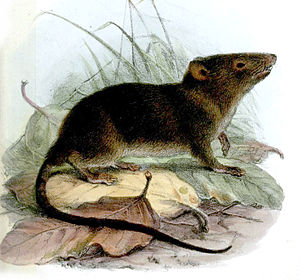Mausopossums
| Mausopossums | ||||||||||||
|---|---|---|---|---|---|---|---|---|---|---|---|---|

Ecuador Opossum Mouse ( Caenolestes fuliginosus ) |
||||||||||||
| Systematics | ||||||||||||
|
||||||||||||
| Scientific name of the order | ||||||||||||
| Paucituberculata | ||||||||||||
| Ameghino , 1894 | ||||||||||||
| Scientific name of the family | ||||||||||||
| Caenolestidae | ||||||||||||
| Trouessart , 1898 | ||||||||||||
| Genera | ||||||||||||
|
The mouse opossums or opossum mice (Caenolestidae) form a family of marsupials and are the only recent representatives of the order Paucituberculata. The family is composed of three genera with seven species.
distribution
Mausopossums inhabit western South America , they are found in the Andes of Colombia , Ecuador and Peru, as well as in southern Chile (on the island of Chiloé and the adjacent mainland).
description
Mausopossums are similar to the shrews . Since these do not occur in South America (except in the far north), mousopossums have partly occupied their ecological niche . Like shrews, they have an elongated head. Their body length is around 9 to 13 cm, with a tail that is roughly the same length. The fur is soft and thick; it is mostly colored brown, gray or black.
Way of life
Mausopossums inhabit moist, cool, and densely forested regions. The genera that live in the Andes inhabit mountainous terrain at an altitude of 2000 to 4000 m. The Chilean species lives in wet forests from sea level to around 1000 m.
They are crepuscular and nocturnal animals that mainly live on the ground, but can also climb well with the help of their tail, which they use as a support. When looking for food, they run quickly forward, and they also create walkways in the thick bushes. While their smell and hearing are excellent, their sense of sight is poorly developed.
The diet of the Mausopossums consists mainly of insects and worms, occasionally also small vertebrates or fruits.
Little is known about the reproduction of the mouse opossums. The females have four to seven teats, depending on the species, but no pouch.
threat
Since mousopossums inhabit very inaccessible terrain, relatively few specimens are seen. Nevertheless, they should still occur relatively frequently. Deforestation in Chile means that the Chilean possum mouse is considered endangered (vulnerable) according to the IUCN .
Systematics
In the Tertiary , when South America was separated from the other continents, the Paucituberculata order was broad and comprised several families. After the immigration of placental mammals with the emergence of the Panama Land Bridge, they were increasingly pushed back, so that today only one family has survived. Together with the opossums , the mouse opossums formed the marsupial superorder Ameridelphia , which, with the exception of the Chiloé opossum , comprised all marsupials on the American continent. The Ameridelphia are now considered paraphyletic . The Mausopossums differ from the Australian marsupials in several ways, for example in that sperm always appear in pairs.
There are three genera with seven species:
- Caenolestes - 5 species: Actual opossum mice
- Lestoros - only species: Peruvian opossum mouse ( Lestoros inca )
- Rhyncholestes - only species: Chilean opossum mouse ( Rhyncholestes raphanurus )
literature
- Ronald M. Nowak: Walker's Mammals of the World . Johns Hopkins University Press, Baltimore 1999. ISBN 0-8018-5789-9